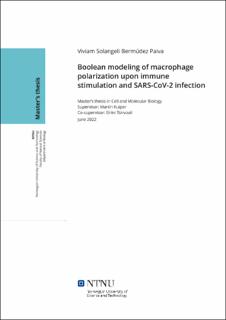| dc.description.abstract | Macrophages are specialized cells of the immune system that can polarize into different phenotypes depending on local conditions, classically an inflammatory macrophage (M1) and alternatively an anti-inflammatory macrophage (M2). Entities involved in eicosanoid biosynthesis play a key role in this process, including the cytosolic phospholipase A2 (cPLA2) and the eicosanoid prostaglandin E2 (PGE2). To better understand the role of these entities and the regulatory factors driving macrophage polarization, a Boolean Macrophage Polarization (MacPol) model was assembled. A previously published model of macrophage differentiation was selected and, by evaluating the literature, expanded with 38 entities and 82 interactions. The MacPol model was able to replicate the gene expression or marker activity profiles for the M1 and M2 phenotypes under polarization stimuli. Then, upon 23 different perturbations and experimental conditions, the model was able to correctly predict 15 expression profiles. The integration of eicosanoid biosynthesis pathways highlighted the role of PGE2 in the polarization of the M2 phenotype. After this, the MacPol model was converted to the Macrophage Activation in COVID-19 (MacAct-C19) model to represent the SARS-CoV-2 infection. Three specific Boolean modules of signaling pathways affected by the virus were generated from the COVID-19 Disease Map repository. The modules together with additional pathways, output process nodes, and inter-cellular interaction nodes were manually integrated into the model. Then, under viral infection conditions, the model was able to replicate the events that lead to the development of the hyperinflammatory response and acute COVID-19. Intra-cellularly, the virus induces (1) silencing of the type 1 interferon signaling pathway, (2) activation of the NLRP3 inflammasome, (3) imbalance of the renin-angiotensin pathway, and (4) constant production of inflammatory cytokines. Inter-cellularly, the macrophage triggers the adaptive response of the immune system by several mechanisms. In conclusion, the models provide a tool to enhance the study of eicosanoids in macrophage polarization and the macrophage response to SARS-CoV-2 infection. These can be implemented in the design of future experiments and new drugs. | |
